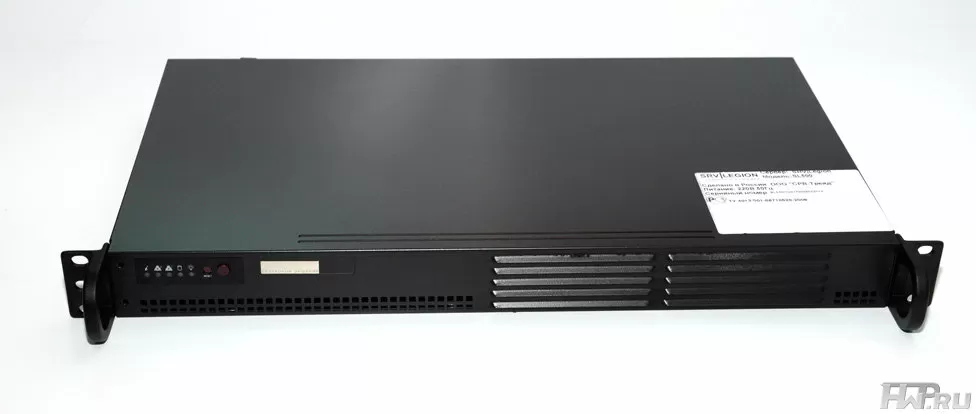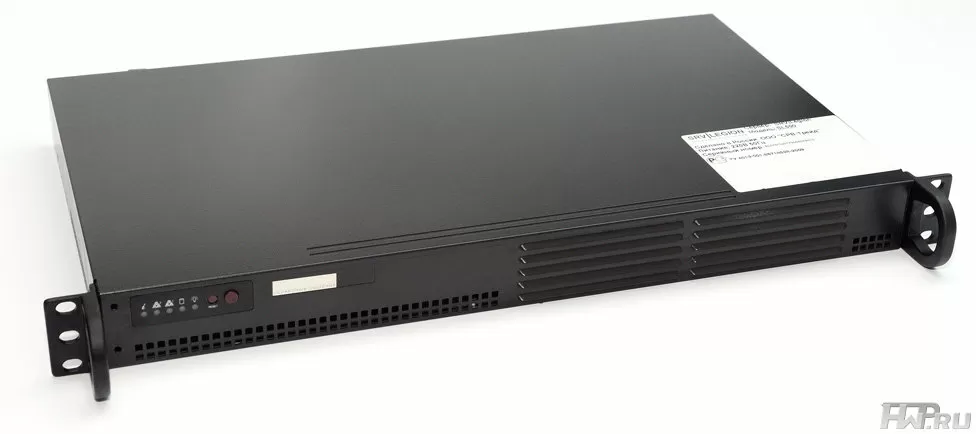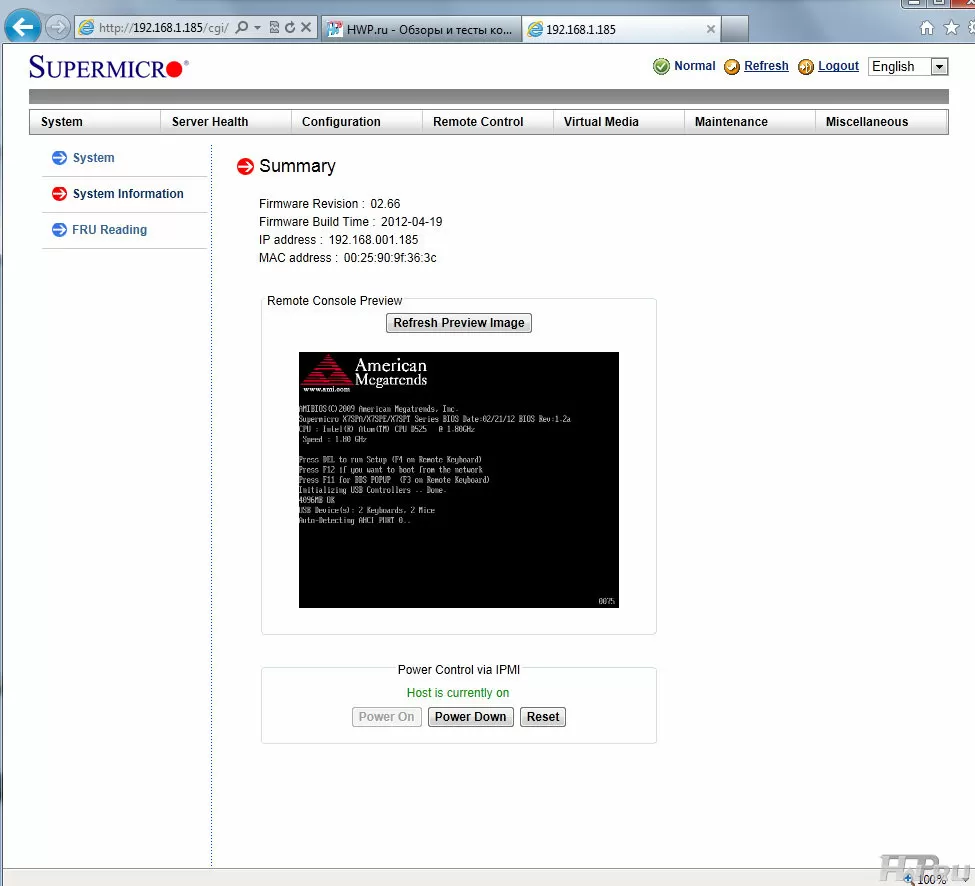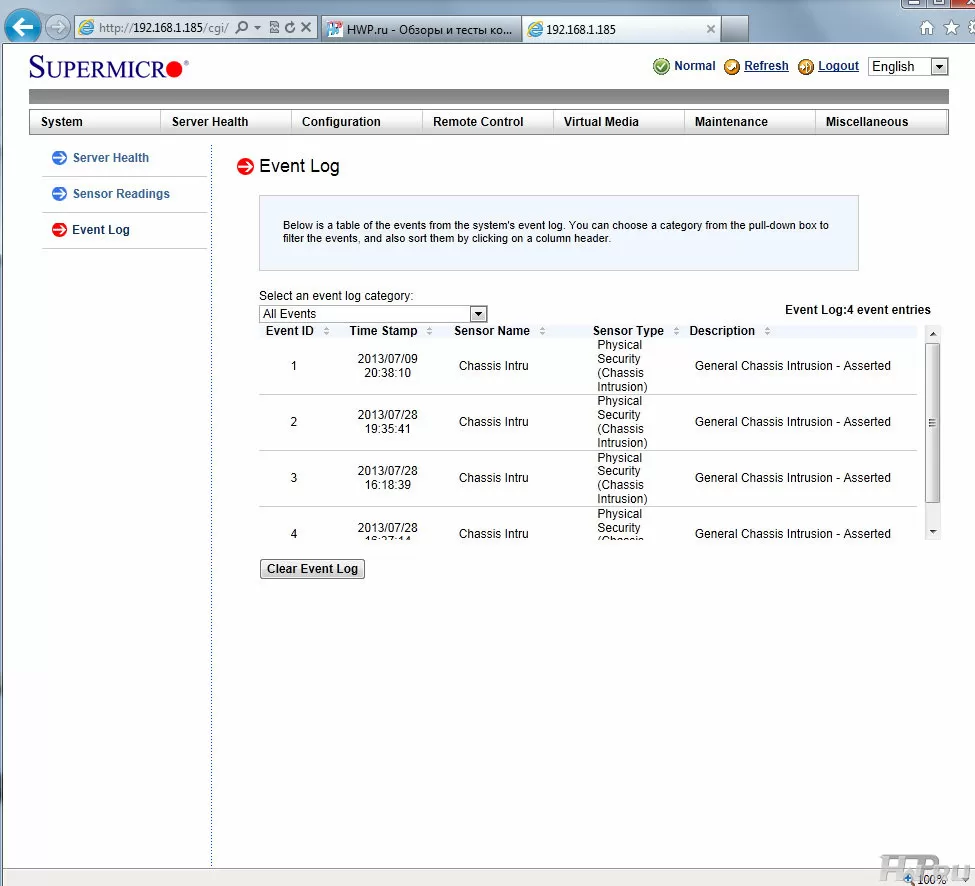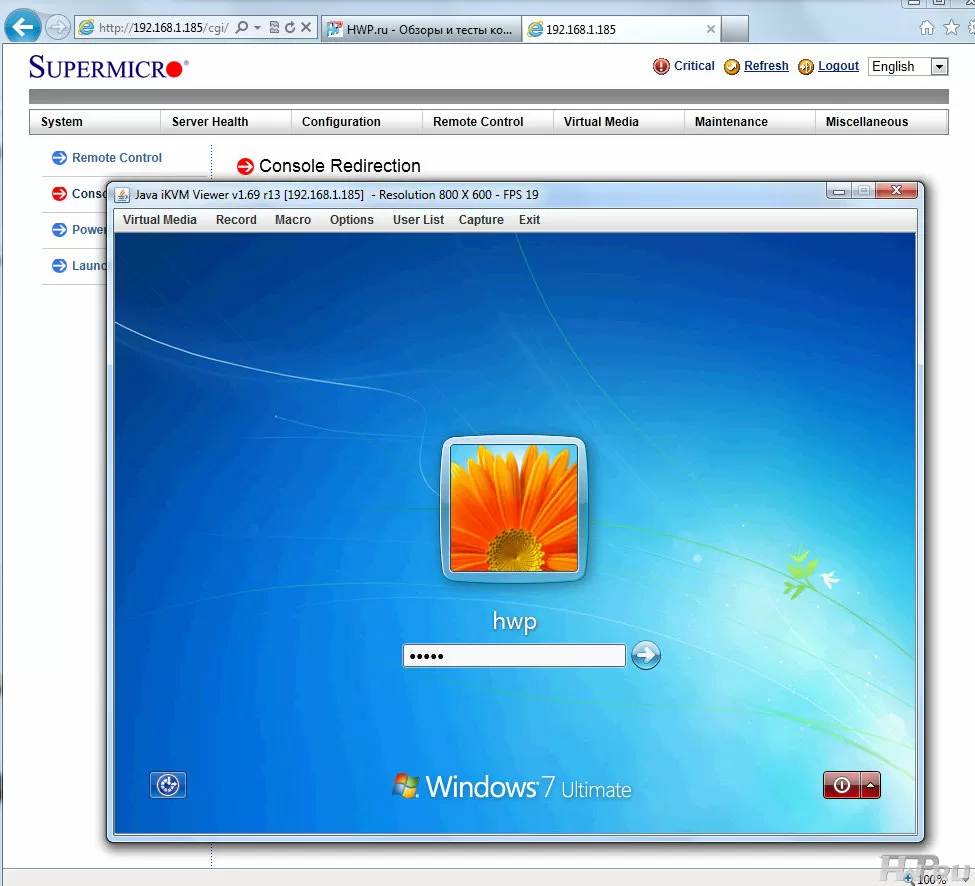Review of SRV-LEGION SL510 server based on Intel Atom 1.8
Low power servers are a relatively new word in the server market. Moreover, this class of devices is very unlucky to emerge in the midst of the general obsession with virtualization, when energy efficiency, and the cost of one virtual server, are becoming so profitable that the idea of saving on the level of hardware appears less and less, giving way to the concept: "I bought a Blade server, configured a hypervisor - and expand it as needed." However, in addition to traditional tasks assigned to server hardware, such as databases, organizing access to files, launching mathematical applications, new tasks have appeared that are more profitable to solve on physical servers.
For example, office telephony. For a small company, it is more profitable to use its own IP telephony server, which will keep track of calls, statistics on users, etc. Such a task does not require large resources, and even some SOHO NAS-s today offer the ability to install Asterisk in a few mouse clicks. Access servers are increasingly used in security systems, whose task is to obtain a pass number from a reader and decide whether or not to open an electronic lock.
Naturally, small organizations often do not have a dedicated room for a data center, and most often when upgrading an existing network, a new server must be integrated into the existing infrastructure. For example, in the familiar 12-inch wall cabinet, which is often located under the ceiling and crammed with network switches. And there can be no question of any air conditioning, or even active cooling, because the staff works in the same room, and unnecessary noise is unacceptable.
There are so few servers that are designed to be installed in 12-inch cabinets that not even every integrator knows about their application. But today we will talk about just such a model - this is the SRV-LEGION SL510 server based on Intel Atom D525 (1.8 GHz), characterized by its compact size, low power consumption, low noise level and an initial cost like a good phone. Let's get started!
Server construction
The dimensions of the SRV-LEGION SL510 server are very compact: 437x43x250 mm, and its weight is only about 4.7 kg. With such dimensions and weight, it does not need runners for mounting in the cabinet, and bolting through the brackets already installed on the case is sufficient.
The server front panel has only a minimal set of indicators and reset and switch buttons. There is no bay for an optical drive, which is quite normal for modern servers, no USB or VGA ports. Again, for a modern server to which you can connect a "virtual disk" via a remote control system, this is not a problem. Perhaps someone will even find that the lack of ports on the front panel is a plus from a security point of view.
An essential part of the front panel is occupied by a ventilation grill, reminiscent of those installed on the walls in residential buildings. We have yet to make sure that the system works without fans, on passive cooling, but for now let's look at the connection ports located on the back of the server.
There are PS/2 ports, two USB 2.0, RS232, VGA ports, as well as two network RJ45 ports. There is also a full height expansion slot. A little frustrating is the lack of an LPT port, which can be useful when connecting any equipment and a dedicated port for management via IP KVM (IPMI). Otherwise, everything matches the device class.
There is a sticker on the server cover, where it is written in large print: "Made in Russia", the serial number and even the TU code (technical conditions) are indicated. The very fact that the server is declared as a Russian product allows it to be used in orders with preferences for Russian-made equipment.
The SRV-LEGION SL510 server can be easily disassembled, but most likely you will not have to do this, since it is already configured by the manufacturer, and most users will not need to add something.
However, let's take a look at the internals.
This server has two 2.5 "(SFF) hard drives. In our case, Hitachi disks were installed, which are positioned by the manufacturer as increased reliability disks and are recommended for installation in nodes with high fault tolerance. It is also possible to install one 3.5 " hard drive.
Due to the presence of hard disks, the expansion card slot transforms from full-profile to low-profile. The PCI Express 4x expansion slot in the PCI-E 16x form factor will allow the installation of most types of expansion cards available today, ranging from network controllers to various specialized devices (demultiplexers, access controllers, etc.). However, for some reason the riser is not supplied with the server.
The Intel Atom D525 processor supports up to 4 GB of unbuffered DDR3 800/667 non-ECC memory, which is loaded with two SO-DIMMs. With today's ridiculous prices for memory, we recommend taking the maximum allowable volume immediately.

Interestingly, the motherboard has as many as 6 SATA ports (3gbps), of which only 2 are involved. which you can connect a USB flash drive or a card reader for MicroSDHC cards, having received another storage medium to which you can backup, from which you can boot, etc. By the way, the motherboard has 8 USB 2.0 ports in total, and only 2 of them are brought to the back of the case. So if you need a server for remote access to USB keys, you can give the only expansion slot for a bracket with external USB ports.

As for the chips, everything is quite standard for Intel Atom D525: Intel ICH9R chipset, two Intel 82574L network controllers, Matrox G200eW graphics core and IPMI remote control controller - Nuvoton WPCM450. All components are well known from other servers and work without problems under Windows and the most popular Linux distributions. There is no support for such corporate functions as TPM, Intel VPro, and even ECC, so you should not assign critical tasks to such servers. Although, servers on Intel Atom have been produced for several years already, they work for years in poor conditions and do not cause trouble for administrators.
It remains to say about the power supply unit: its power of 200 W is more than enough for this server in the maximum configuration. The PSU has passive power factor compensation, but nothing is said about efficiency, and it does not have an 80 Plus certificate.
In general, if we talk about the construction of this server, then in this price category you can expect any surprises. Fortunately, in our case everything is quite competent and high-quality: the wires are laid neatly, the disks are located at a considerable distance from the board. And although the feeling of distrust in the system with passive cooling does not leave, we are inclined to believe that the platform developer, Supermicro, tested the server thermal package. Well, there is only one way to check - this is to test this server using our traditional program.
BIOS and IPMI Remote Management
The SRV-LEGION SL510 server has AMI BIOS specific to Supermicro products. The BIOS also contains settings that are not characteristic of this model, such as the speed of the fans, which are not installed here, and various energy-saving options. What you should pay attention to? First of all, on the built-in RAID controller: the motherboard uses the Intel ICH9R SATA 3.0 Gbps south bridge, which has two host controller emulation modes: Intel, which is recommended for use with the Windows operating system, and Adaptec, which traditionally has good support in Linux distributions. You can also download over the network.
As it should be for server motherboards, there are Watchdog settings here that can reboot the server if the operating system is frozen, as well as a remote network management (IPMI) complex, which should be discussed in more detail .
In general, every self-respecting server manufacturer has remote monitoring. With its help, you can not only monitor the state of the server, but also get console KVM access to it without additional equipment, and, most importantly, connect virtual disks. Thus, the system administrator can install the operating system without even having physical access to the server - over the network, with a virtual disk image, and there is no need to spend money on IP KVM.
It is very important to understand that in SRV-LEGION SL510 remote control is rigidly tied to the first LAN port, and the hardware monitoring system is activated and receives an IP address when the power cord is connected (if a server is installed in the same network segment DHCP), even before turning on the server itself, and it works independently of it, allowing you to manage power and overload the machine.
Among the capabilities of IPMI, it should be noted hardware monitoring of all components, a list of installed components with their FRU numbers (works only for Supermicro components), so that you know where what is installed without rummaging in documents, as well as recording the process of passing POST tests before booting the machine to see what errors occurred, if any. The software console itself is written in JAVA by ATEN, a leader in IP KVM.
I don’t know how correct it would be to compare IPMI remote monitoring and management with HP ILO or Dell iDRAC systems, but everything that is necessary for remote server deployment and maintenance, as well as for constant monitoring of it, is present here states. More importantly, it is a built-in, fully hardware system that works out of the box and does not require the purchase of additional licenses.
Testing
Such servers work primarily as auxiliary machines, so during testing we were interested in such issues as file system speed, work as a network storage device and power consumption. We used Windows 7 Maximum 32-bit operating system as the most suitable for this machine.
Server Configuration
- Processor - Intel Atom D525 (1.8 GHz)
- Memory - 4GB DDR3 SDRAM
- Hard drives - 2x Hitachi TravelStar Z5K320 (250 Gb, 5400 RPM, 8 Mb, SATA-300)
- Windows 7 Ultimate
First of all, I would like to say about the noise level and power consumption. For the kid, the SRV-LEGION SL510 turned out to be quite noisy, and the reason is the power supply fan. I've seen 2U servers with 2 processors and 8 hard drives that are quieter, but at the same time, you can be near this server and not feel too much discomfort. As for the power consumption, during testing it fluctuated from 30 to 50 W , which seems to be not so much, however, not so little. In comparison, modern 2-socket servers with 4 SAS hard drives rarely consume more than 200 watts.
Let's start the tests with the disk subsystem. It is logical to combine two hard drives in RAID 1 (mirror) to increase fault tolerance. In this mode, the disk subsystem allowed to achieve performance of about 60 MB/s for reading and the same for writing. To tell you the truth, this is very little, even for a laptop, let alone a server.
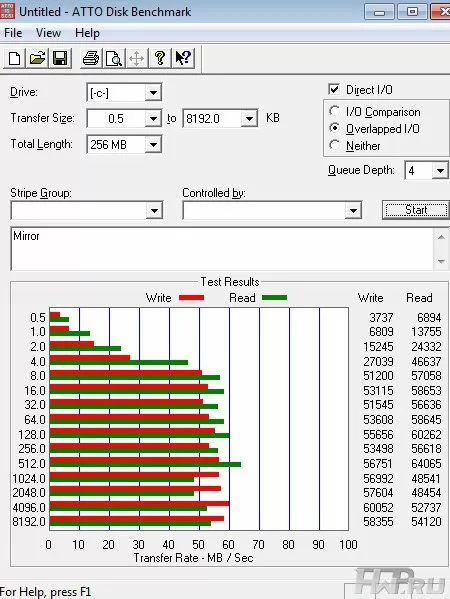
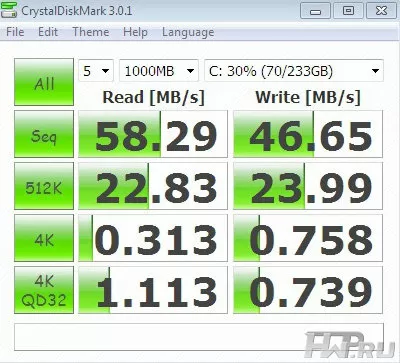
When using the SL510 as a NAS under Windows 7, you will get slightly lower results - about 30-40 MB/s for reading and writing.
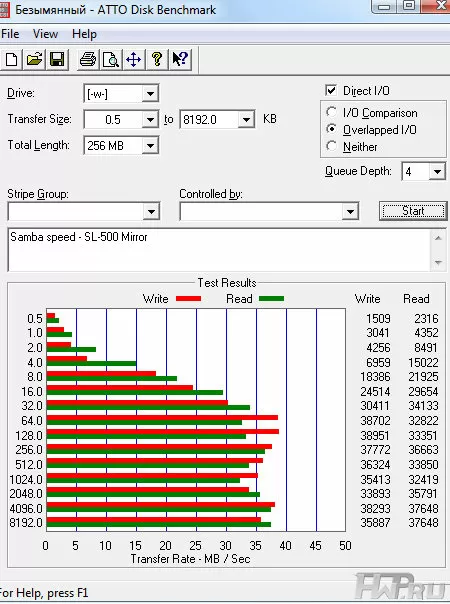
With regard to processor performance, in principle, it is sufficient for simple applications. Fans of benchmark numbers can compare our results in the Super Pi and Fritz Benchmark tests.
|
Fritz CPU Benchmark Results | |
| Relative Speed | 3.61 |
| Kilonodes p/s | 1731 |
Tests show that the trump card of such servers, nevertheless, is low power consumption, and not performance in specific tasks. The processor and memory speed is sufficient for simple applications or I/O operations. For example, I know of several cases when simple, but at the same time, effective CRM systems were launched on such simple servers, etc. But, of course, the main indisputable advantage of SRV-LEGION SL510 servers is their low purchase cost and low cost of ownership.
Issue price
In the configuration we tested, the SRV-LEGION SL510 server cost $ 730. The starting price of a machine without hard drives is only $ 530. These servers are comparable in price to SOHO NAS and are available to virtually any organization.
Conclusions
The key factor when choosing SRV-LEGION SL510 servers is their form factor, as well as the power consumption restrictions imposed by the conditions of use: compact, cheap and not very loud, this is an ideal solution for working there, where there is no space and no need for traditional expensive 1U servers. Such machines successfully fit both into the existing infrastructure and put at the head of any projects for non-energy-intensive tasks, such as processing data from sensors, alarms, working with mail, etc.
The server is a bit noisy for its format, so it should not be installed in a room where people work, and even in an open rack, unless absolutely necessary. You also need to understand at the ordering stage that most likely you will not be able to upgrade the server - there is nothing to change except hard drives. And if there were one and a half to two dozen such compact servers on the market, one could talk about the disadvantages and advantages in relation to competitors. But there is practically no choice here, so you can just say thanks to Supermicro, which released such a platform and remember where to go in case you need an inexpensive compact solution in 1U format.
Mikhail Degtyarev (aka LIKE OFF)
12/08.2013

